Why Mortuary Tools Are Essential for Professional Funeral Services
Mortuary Tools are specialized instruments used by funeral professionals to preserve, prepare, and honor the deceased with dignity and respect. These essential tools enable mortuary professionals to carry out embalming, body preparation, and viewing arrangements that provide closure for grieving families.
Essential mortuary tools include:
- Embalming instruments - scalpels, forceps, arterial tubes, and trocars for body preservation
- Embalming machines - Portiboy units that control fluid pressure and flow for efficient preparation
- Autopsy equipment - bone saws, rib shears, and post-mortem needles for examination procedures
- Storage solutions - mortuary coolers and refrigeration units to maintain bodies at proper temperatures
- Safety equipment - PPE, disinfection systems, and ventilation tools for staff protection
- Transport tools - mortuary cots, church trucks, and lifting devices for safe body handling
The global mortuary equipment market is projected to reach $1.5 billion by 2027, driven by increasing demand for advanced embalming and refrigeration tools. Modern embalming machines like the Portiboy can reduce preparation time by up to 30% while improving preservation outcomes.
I'm Mortuary Cooler from American Mortuary Coolers, a national-level mortuary cooler supplier with extensive experience helping funeral professionals select the right mortuary tools for their facilities.
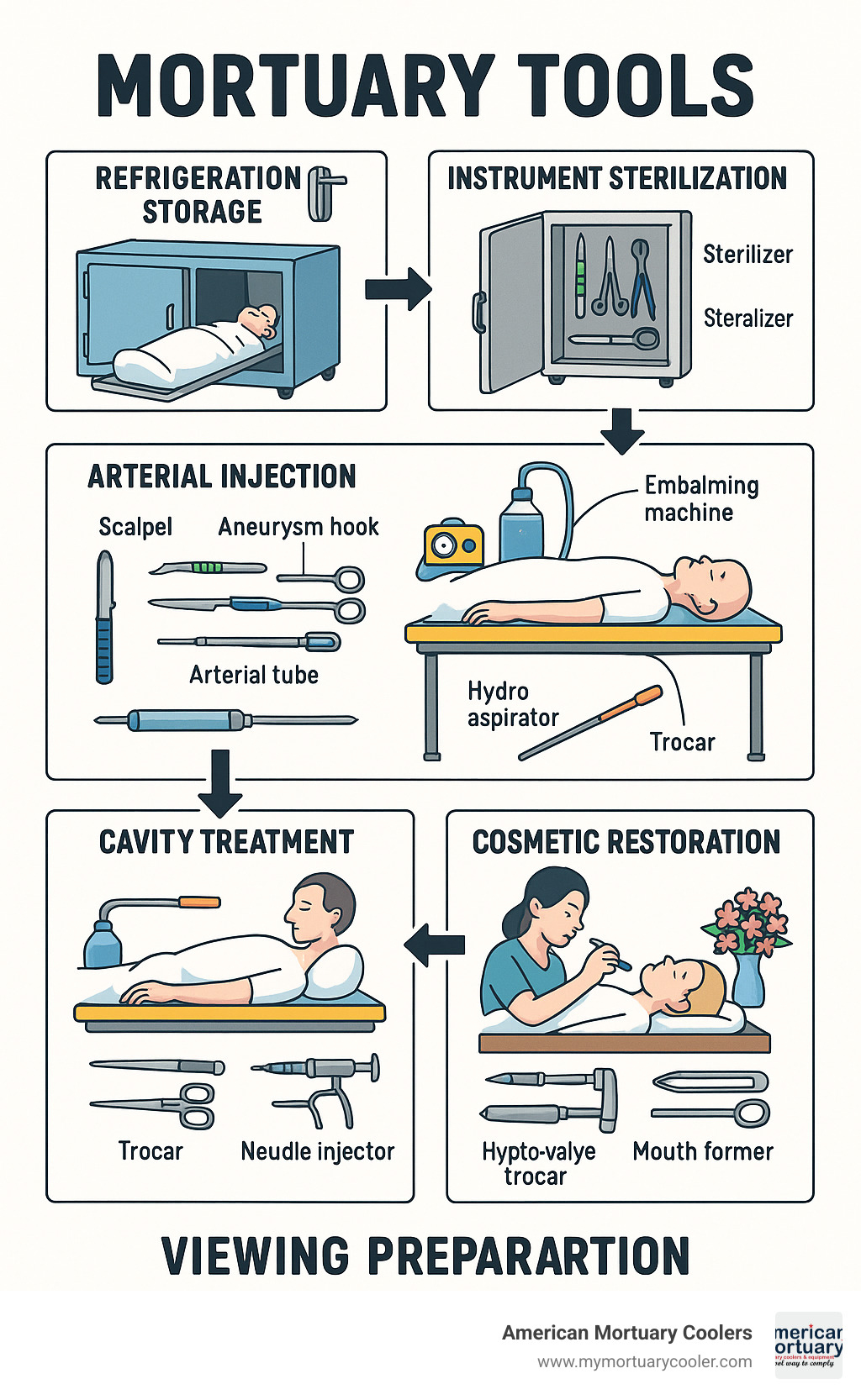
Mortuary Tools definitions:
Understanding Mortuary Tools and Their Significance
Mortuary Tools serve a profound purpose: they help preserve dignity while providing families the closure they need. Every scalpel, embalming machine, and storage cooler plays a role in slowing decomposition and ensuring safe handling throughout the preparation process.
When we use these tools skillfully, we give families the gift of saying goodbye to someone who looks peaceful and natural. The global mortuary equipment market's growth to $1.5 billion reflects humanity's universal need to treat loved ones with respect after death.
Main Categories of Mortuary Tools
Embalming instruments are the workhorses of prep rooms. Arterial tubes deliver preservation fluids precisely, while forceps handle tissues gently. Scalpels make clean incisions, and trocars handle cavity treatment.
Autopsy equipment serves examination needs. Bone saws, rib shears, and post-mortem needles allow thorough work while maintaining tissue integrity for later restoration.
Refrigeration systems are essential for proper storage. Modern mortuary coolers with telescoping slide rails can hold 2-3 bodies per unit while maintaining optimal temperatures.
Lifting and transport equipment protects staff and the deceased. Mechanical lifts, transfer boards, and mortuary cots prevent injury while ensuring dignified movement.
Personal protective equipment usage jumped over 40% since 2020. Quality gloves, gowns, masks, and face shields keep teams safe so they can continue serving families.
For detailed information about specific tools: Tool Talk: A Deep Dive into Mortuary Tools.
How Mortuary Tools Uphold Dignity & Cultural Sensitivity
The tools we choose directly affect our ability to honor diverse beliefs and customs around death. Reconstruction capabilities become crucial for difficult cases, allowing families meaningful closure regardless of circumstances.
Religious customs vary enormously in preparation requirements. Comprehensive tool collections accommodate diverse needs without compromising beliefs or values. Family expectations center on dignity and respect - when families see someone who looks peaceful, it validates their trust and provides comfort.
Essential Embalming and Mortuary Equipment: Categories, Instruments & Machines
Arterial tubes are precisely engineered for different vascular systems. Curved tubes work for carotid artery access, while straight tubes handle other injection points, ranging from 3/32" to 5/16" diameter.
Forceps are embalming workhorses. Aneurysm hooks gently cradle blood vessels for tube insertion, tissue forceps handle delicate structures, and fixation forceps hold everything steady during suturing.
Scalpels with disposable blades stay sterile and sharp, while quality handles provide control for precise incisions. Trocars handle cavity treatment, removing fluids and injecting preservatives directly where needed.
Aspirator systems have revolutionized fluid removal. Hydro aspirators use water pressure for powerful suction, while anti-clogging designs maintain smooth operation and significantly reduce preparation time.
Embalming tables need durability. Modern tables with 14-gauge 304 stainless steel construction feature deep troughs and efficient drainage. Hydraulic models support up to 1,000 pounds while adjusting from 32 to 38 inches height.
Mortuary coolers bridge the gap between arrival and preparation. Proper refrigeration affects both preservation quality and family satisfaction, maintaining dignity throughout the process.
For comprehensive equipment guidance: Essential Mortuary Equipment: A Professional's Guide to Key Funeral Supplies.
Key Components of a Standard Embalming Instrument Kit
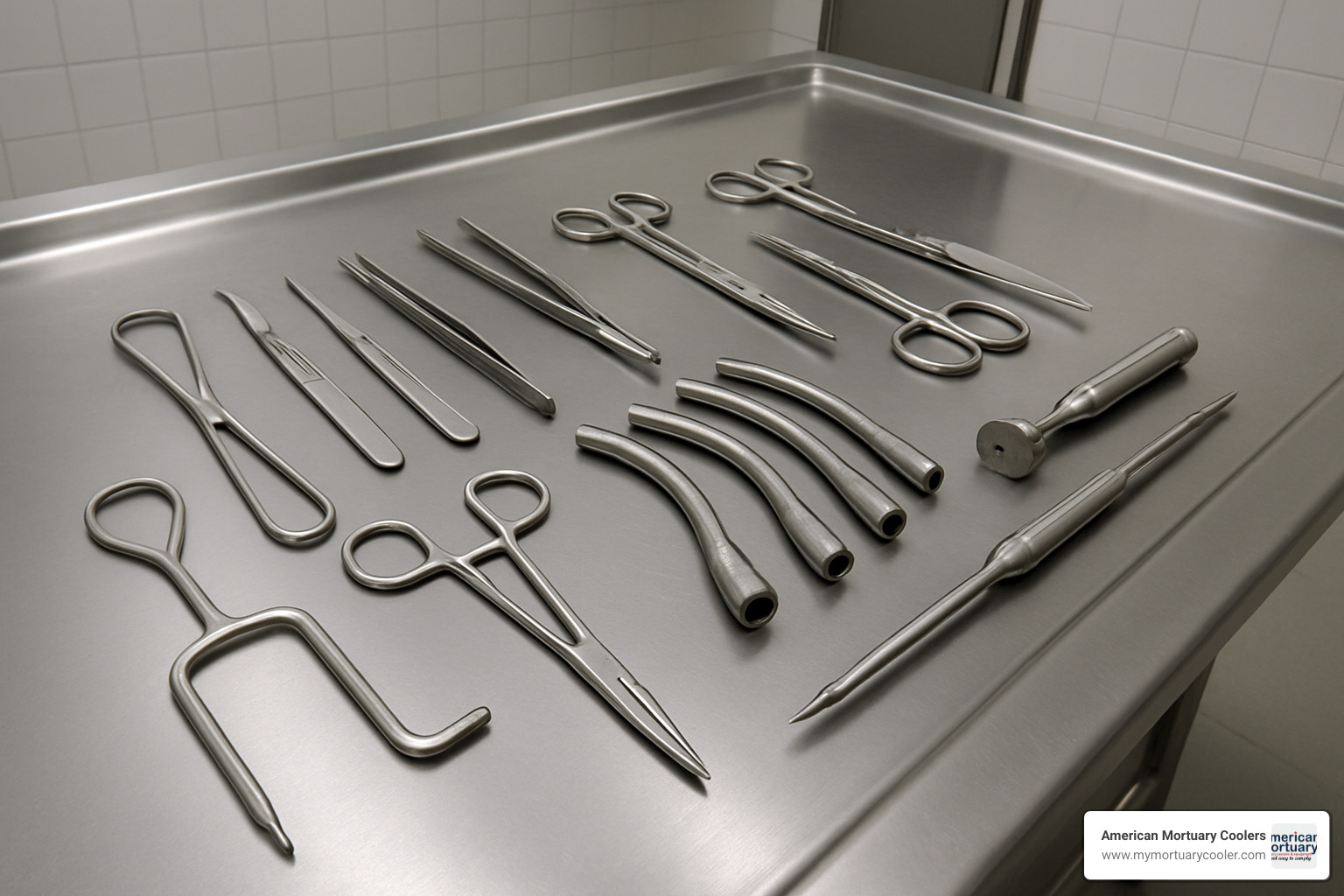
Professional embalming kits contain over 20 specialized instruments. The scalpel and handle combination provides primary cutting capability with disposable blades for different requirements.
Metzenbaum scissors offer surgical precision for tissue separation, while Adson forceps allow gentle handling of delicate structures. Aneurysm hooks create clean arterial access without crushing vessels.
Needle injectors target areas arterial injection might miss, while suture needles in curved configurations handle different closure requirements. Kidney dishes organize instruments professionally.
Trocar buttons and applicators seal cavity work entry points, preventing leakage. Arterial tube slip hubs in various sizes create secure connections for effective fluid delivery.
For forceps selection guidance: The Complete Guide to Forceps: Types and Uses Explained.
The Role of Embalming Machines & How They Work
Portiboy embalming machines represent major advancement over hand-pump systems, reducing preparation time by up to 30% while improving preservation outcomes.
Pressure control transforms embalming from guesswork to precision, maintaining steady pressure for even fluid distribution. Flow meters provide real-time monitoring, allowing adjustment based on body size and preservation requirements.
Cavity injection capabilities deliver chemicals directly to organs arterial injection might miss. Safety features include pressure relief valves and precise flow controls protecting operators and tissues.
Comparing Traditional Hand Pumps vs. Modern Portiboy Machines
| Feature | Traditional Hand Pumps | Modern Portiboy Machines |
|---|---|---|
| Setup Time | 15-20 minutes | 5-10 minutes |
| Pressure Range | Variable, operator-dependent | Consistent, 0-25 PSI |
| Safety Valves | Manual monitoring required | Automatic pressure relief |
| Maintenance Cost | Low initial, high labor | Higher initial, lower labor |
| Consistency | Varies by operator skill | Standardized results |
Evolution and Innovations in Mortuary Tools
Mortuary Tools evolution reflects our commitment to dignity and respect. Early 19th-century embalming used crude syringes and hand pumps that demanded enormous physical effort while producing inconsistent results.
The shift to stainless steel revolutionized instrument quality and safety. Modern tools resist rust, stay sharp longer, and handle repeated sterilization - providing the reliable, hygienic service families deserve.
Digital autopsy technology represents the biggest breakthrough. Modern CT and MRI scanners create detailed 3D models without invasive procedures, cutting examination time from hours to under 30 minutes while eliminating invasive procedures in 70% of cases.
Smart cooler systems now monitor temperature and humidity continuously, alerting staff to any changes affecting preservation quality. This technology gives funeral directors confidence their equipment actively protects families.
Traditional vs. Modern Mortuary Tools: Key Differences
Materials have transformed from rust-prone carbon steel to high-grade stainless steel alloys lasting decades. Ergonomics now focus on balanced instruments with comfortable grips preventing strain during procedures.
Automation removes guesswork from embalming through consistent pressure and flow control. Data logging records procedures for continuous improvement, while infection control features include antimicrobial coatings and simplified sterilization.
Modern innovations continue advancing death care while maintaining dignity and respect.
Latest Technologies Changing Prep Rooms
Digital autopsy suites bring advanced imaging into funeral homes, allowing non-invasive examinations respecting cultural preferences. Waterless embalming fluids address environmental concerns without sacrificing preservation quality.
Telescoping slide-rail coolers accommodate 2-3 bodies per unit while improving workflow efficiency. Hydro aspirators use water pressure for powerful suction without electric pumps, while bone-dust vacuums provide specialized cleanup during procedures.
Safety, Hygiene, and Maintenance Best Practices
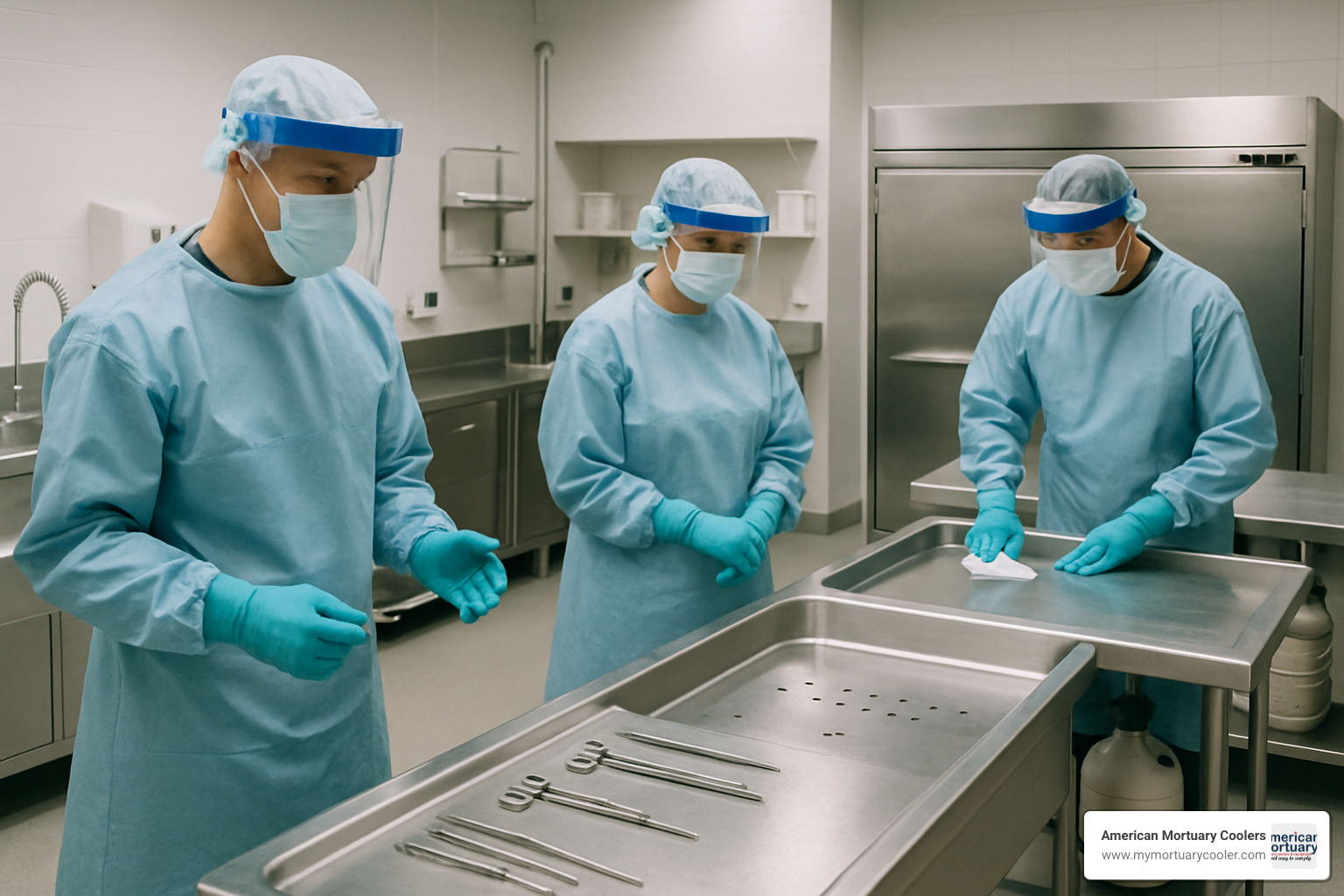
Working with Mortuary Tools requires unwavering attention to safety and hygiene. PPE usage in mortuary settings surged over 40% since 2020, reflecting heightened awareness of occupational hazards in death care work.
Personal protective equipment serves as first-line defense against biological materials, chemical preservatives, and sharp instruments. Quality gloves protect against bloodborne pathogens, chemical-resistant gowns shield from embalming fluid splashes, and face shields guard against airborne particles.
Disinfection protocols must become routine. UV light systems offer chemical-free sterilization, while traditional disinfectants handle surface contamination. Sharps handling demands constant vigilance - proper disposal containers and careful techniques prevent life-changing accidents.
For comprehensive safety equipment guidance: Mortuary Must-Haves: A Comprehensive Equipment List.
Cleaning & Sterilizing Mortuary Tools for Longevity
Autoclave sterilization remains the gold standard for heat-resistant instruments. Steam sterilization at 121°C for 15-20 minutes eliminates microorganisms while preserving stainless steel integrity.
Chemical soaking provides alternatives for heat-sensitive items. Glutaraldehyde solutions effectively sterilize rubber components and electronics without damage. Stainless steel care requires specific attention - protein deposits can cause corrosion if untreated.
Cleaning checklists ensure consistent protocols across staff, eliminating variability and improving hygiene standards while providing regulatory compliance documentation.
Staff Safety Protocols & Regulatory Compliance
OSHA requirements establish minimum safety standards covering hazard communication and bloodborne pathogen protection. CDC guidelines provide disease-specific recommendations that evolve with infectious disease understanding.
Ventilation requirements remove chemical vapors and biological contaminants, while spill kits enable rapid containment of hazardous materials before facility-wide spread.
How to Choose the Right Mortuary Tools & Trusted Suppliers
Choosing the right Mortuary Tools requires balancing quality, budget, and your facility's unique needs. Quality tools cost more upfront but serve faithfully for years, actually saving money over time.
Case volume determines equipment needs. High-volume facilities need robust, automated equipment, while smaller homes often benefit from versatile manual tools. Service offerings should drive decisions - don't buy equipment for services you don't provide.
Warranty and training support become critical when equipment problems could shut down operations. The best suppliers provide comprehensive warranties and necessary staff training.
Trusted suppliers include Portiboy for embalming machines, Mopec for specialty equipment, and Junkin for transport devices. Professional associations like NAFD and SAIF offer valuable equipment selection resources.
Evaluating Features, Materials, and After-Sales Support
Stainless steel quality affects longevity and performance. Most tools use 304-grade stainless steel, while coastal facilities benefit from 316-grade's superior corrosion resistance.
Adjustability features prevent staff strain and improve efficiency. Modular design provides expansion flexibility without replacing entire systems. Supplier responsiveness becomes your lifeline during equipment breakdowns.
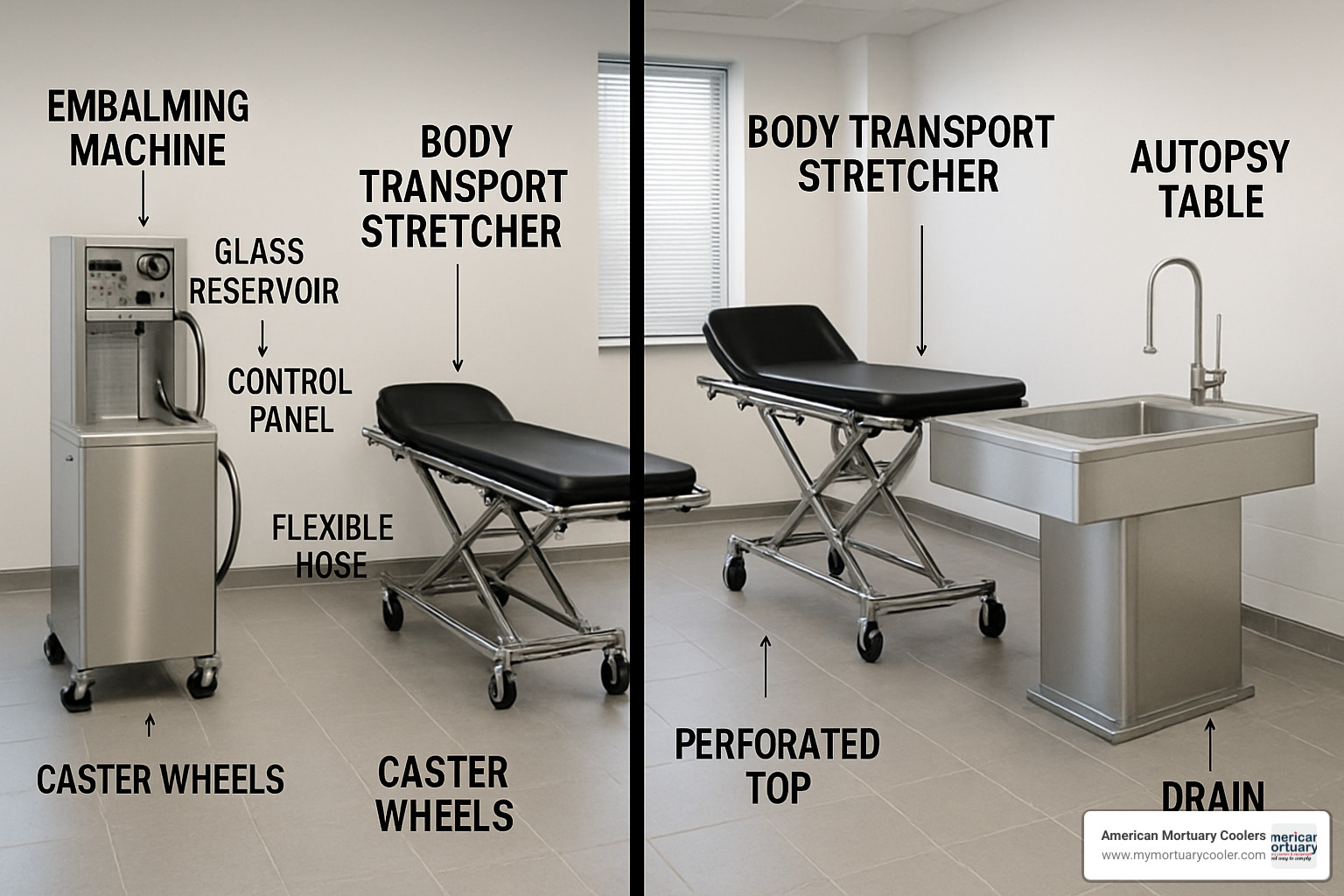
The relationship with your equipment supplier matters as much as the tools themselves. Look for suppliers understanding funeral industry challenges and providing solutions fitting your specific needs.
Frequently Asked Questions about Mortuary Tools
What are mortuary tools and why are they important?
Mortuary Tools are specialized instruments making professional funeral service possible. They serve families during vulnerable moments, allowing us to handle their loved ones with care and dignity.
These tools matter because they slow decomposition, prevent disease transmission, and restore natural appearance for viewing. Most importantly, they give families the gift of closure - changing potentially traumatic experiences into healing ones.
How have mortuary tools evolved over time?
Mortuary Tools evolution shows human ingenuity meeting compassion. 19th-century morticians worked with basic hand pumps and simple scalpels, producing inconsistent results through exhausting manual work.
Stainless steel construction changed everything - instruments could withstand sterilization without rusting while staying sharp longer. Today's digital autopsy technology uses CT and MRI imaging for non-invasive examinations, while modern embalming machines provide precise pressure control impossible with hand pumps.
The core mission remains unchanged: treating every person with dignity while helping families heal.
What is included in a standard embalming instrument kit?
Professional kits contain over 20 specialized instruments. Cutting instruments include scalpel handles with disposable blades and Metzenbaum scissors for delicate work. Manipulation tools feature Adson forceps for tissue handling and aneurysm hooks for arterial access.
Injection equipment includes arterial tubes in various sizes and needle injectors for targeted treatment. Suturing supplies provide closure capabilities, while organization tools like kidney dishes maintain professional workspace standards.
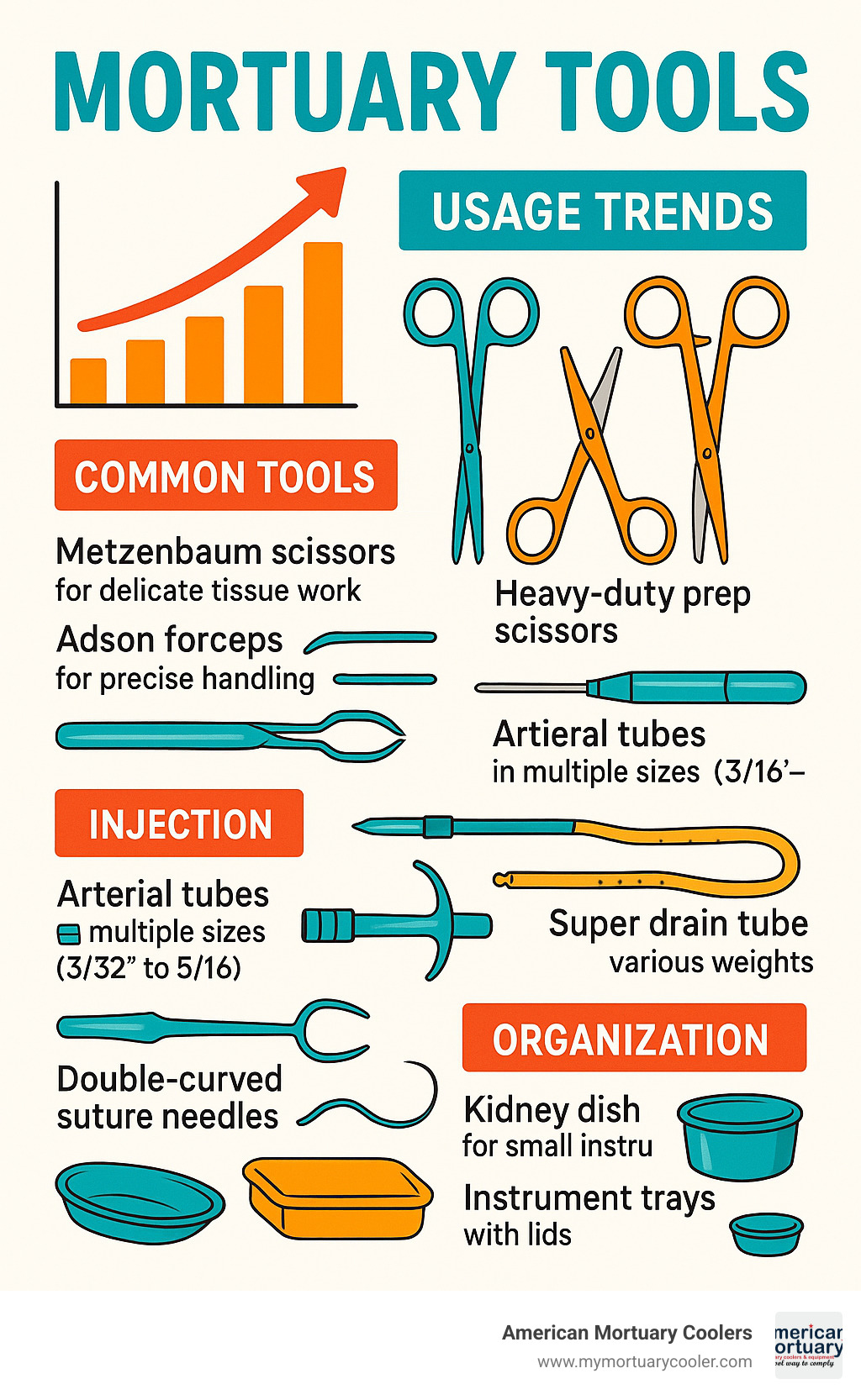
Conclusion
Mortuary Tools continue evolving with innovations improving both technical capabilities and respectful treatment of the deceased. From digital autopsy systems to smart refrigeration monitoring, these advances serve our fundamental mission of honoring those who have passed while comforting their families.
Modern mortuary tools represent the intersection of advanced technology and timeless respect for human dignity. Whether using traditional scalpels or sophisticated embalming machines, the principle remains constant: treating every individual with deserved care and respect.
Choosing the right tools requires careful consideration of your facility's needs, budget, and services. Quality instruments provide better results, last longer, and serve families more effectively than cheaper alternatives.
Proper maintenance ensures tools continue performing reliably when families need services most. Regular cleaning, sterilization, and preventive care protect both your investment and service excellence.
At American Mortuary Coolers, we understand quality equipment forms the foundation of exceptional funeral service. Our custom mortuary coolers help funeral professionals across the contiguous 48 states provide dignified care with reliable solutions.
Whether establishing new facilities or upgrading existing equipment, the right mortuary tools make all the difference in serving families with compassion and professionalism. Choose wisely, maintain carefully, and remember that behind every tool is a family seeking comfort during their most difficult time.
For comprehensive mortuary equipment solutions: More info about key cooler solutions.
















